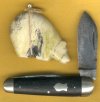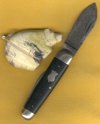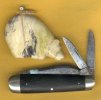- Joined
- Oct 28, 2006
- Messages
- 5,978
Forgive me for asking what would probably be a stupid beginners question.... that beautiful Sleeve-board whittler, with the different stampings, and it appearing to be a unique assembly of out-contracted knife parts ( blades ) would ( or should ) this be more desirable to the Collector?
IMHO (and a very good question)... and take my opinion with a grain of salt. I think if the knife has never been apart, it is an indication that back when the knife was assembled, the little stamps on the blades did not matter much to the end result. But it is curious to think where the knife actually was distributed to. Those jumbo whittlers are extremely collectible anyway. In this case, the pattern itself and the condition completely trump how the blades are stamped, but I would think if it comes down to value, which is sort of moot, a like pattern with all blades stamped Ulster Knife Co would bring a higher selling price.











